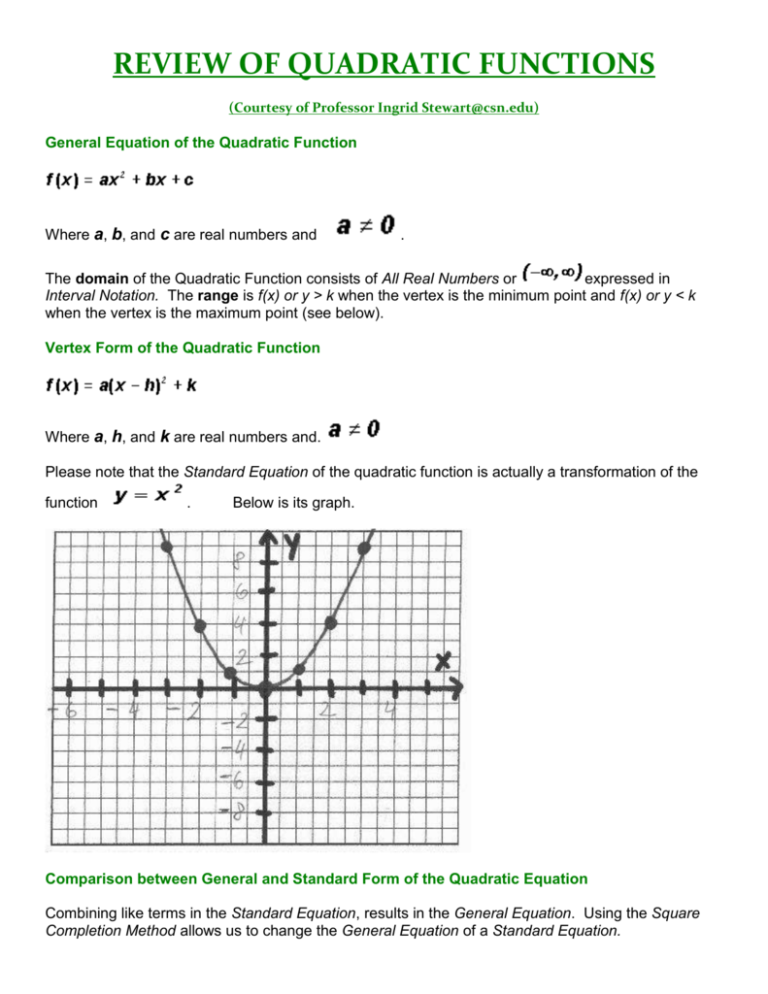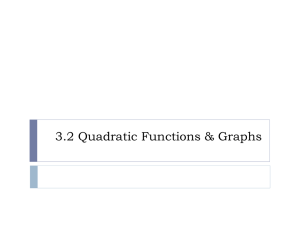review of quadratics
advertisement

REVIEW OF QUADRATIC FUNCTIONS (Courtesy of Professor Ingrid Stewart@csn.edu) General Equation of the Quadratic Function Where a, b, and c are real numbers and . The domain of the Quadratic Function consists of All Real Numbers or expressed in Interval Notation. The range is f(x) or y > k when the vertex is the minimum point and f(x) or y < k when the vertex is the maximum point (see below). Vertex Form of the Quadratic Function Where a, h, and k are real numbers and. Please note that the Standard Equation of the quadratic function is actually a transformation of the function . Below is its graph. Comparison between General and Standard Form of the Quadratic Equation Combining like terms in the Standard Equation, results in the General Equation. Using the Square Completion Method allows us to change the General Equation of a Standard Equation. The Zeros or Roots of Quadratic Functions The Zeros, sometimes also called Roots, of a quadratic function are number replacements for x yielding a y-value of 0. Quadratic functions have two Zeros, which do not have to be distinct (different). Zeros can be real or imaginary. The real Zeros are the x-intercept(s) of the graph of a quadratic function. Imaginary Zeros occur in conjugate pairs (Conjugate Pairs Theorem). A number r is a Zero of a quadratic function if f(r) = 0. If a number r is a Zero of the polynomial function, then (x - r) is a linear factor of the function and vice versa. Note: "Linear factors" are of the form ax + b, where a and b are constants. Finding Zeros of Quadratic Functions Set the quadratic function equal to 0 and solve for x using the following methods. The solutions for x, real and imaginary, are considered Zeros of the quadratic function. Factoring and the Zero Product Principle - Some, but not all quadratic equations can be solved by factoring. Write the quadratic equation in standard form. That is, using Properties of Equality, bring all terms to one side of the equation so that the other side is equal to 0. Combine like terms, if possible. Factor relative to the integers. Use the Zero Product Principle to solve. That is, if a product is equal to 0, then at least one of the factors is equal to 0. Square Root Method - If u is an algebraic expression containing a variable and d is a constant, then has exactly two solutions, namely and or simply Isolate the squared term on one side of the equation. Be sure its coefficient is a positive 1 !!!!!! Apply the Square Root Property. If necessary, further isolate the variable. Quadratic Formula Method - The solutions of a quadratic equation in general form with are given by . Write the quadratic equation in standard form. That is, using properties of equality, bring all terms to one side of the equation so that the other side is equal to 0. Combine like terms, if possible. a is the coefficient of , b is the coefficient of x, and c is the constant. Note: b and/or c can be zero or a negative number!!! a cannot be equal to zero, but it can be negative. Substitute the values of a, b, and c into the quadratic formula. Be sure to note that a negative value for b in the quadratic equation does not replace the negative sign in front of b in the formula. Perform all arithmetic operations to find simplified solutions, such as adding like terms, simplifying square roots, and reducing fractions. Characteristics of Graphs of Quadratic Functions The graphs of quadratic functions are so popular that they were given their own name. They are called parabolas. The graph is SMOOTH and symmetric to a line called the axis of symmetry. This means that the two sides of the parabola on either side of the axis of symmetry look like mirror images of each other. The point where the axis of symmetry intersects with the parabola, is called the vertex. The graph is U-shaped at the vertex. The graph is NEVER parallel to the y-axis. Instead it moves away from it at a steady pace. There is always a y-intercept. There are at most two x-intercepts. This means that some parabolas may have no xintercept, while others may have one or two x-intercepts. The graph of a quadratic function upward when the leading coeffiient a > 0. opens In that case, the vertex is the minimum point on the graph. That is, there is no other point on the graph whose y-value is lower. The graph of a quadratic function downward when the leading coefficient a < 0. opens In that case, the vertex is the maximum point on the graph. That is, there is no other point in the graph whose y-value is higher. Given a quadratic function in the form : The equation of the axis of symmetry is x = h. The coordinates of the vertex are (h, k). Given a quadratic function in the form: : . The b and the a come from The equation of the axis of symmetry is . The coordinates of the vertex are Please note that . and k = f(-b/2a) The Maximum or Minimum Value of the Quadratic Function: If the leading coefficient of the function a > 0 (positive), we have a minimum point, namely the vertex. The minimum value value of the function is the y-coordinate of the vertex point. If the leading coefficient of the function a < 0 (negative), we have a maximum point, namely the vertex. The maximum value of the function is the y-coordinate of the vertex point. Determining where the Quadratic Function is Increasing and Decreasing The quadratic function is said to increase on an open interval along the x-axis if the graph of the function goes up from left to right. The quadric function is said to decrease on an open interval along the x-axis if the graph of the function goes down from left to right. Strategy for Graphing Quadratic Functions Create a Coordinate Plane System. Find and plot the coordinates of the vertex. Find and plot the Axis of Symmetry as a dashed vertical line. Find and plot the points at which the graph crosses or touches the x-axis (there might be none, one, or two). Find and plot the point at which the graph crosses or touches the y-axis (there is always exactly one). Find and plot 3-5 other points to better facilitate the shape of the graph, particularly the U-shaped vertex! Connect all points in the shape of a parabola.









